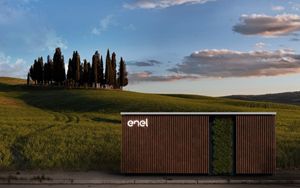(Tiper Stock Exchange) – Enel Grids revolutionizes the design of its secondary cabins, making them even more sustainable and in harmony with the urban environment, and it does so thanks to Enel Boxthe new design concept thanks to which the cabins will be made with low environmental impact materials and with a reduced number of components, thus minimizing the carbon footprint of the infrastructures and facilitating their integration into the urban, rural and historic areas.
“To enable the energy transition and proceed quickly towards a zero-emissions future, we need increasingly sustainable, resilient and interactive distribution networks – he said Antonio Cammisecra, head of Enel Grids –. Precisely to achieve this goal, the Group has adopted the Grid Futurability approach, collaborating with all stakeholders to rethink the key components of its grid infrastructure in an open and cooperative ecosystem. Secondary substations are an important part of our future investments, and just last year we built one a day in Italy. The cabin of the future will be an icon of decentralized intelligence to best accommodate renewable generation, flexibility and all the new needs related to the electrification of consumption”.
The new design of the secondary substations “Enel Box”, elaborated by Eugenio Bini, is part of the broader process launched by Enel Grids for the sustainable re-design of essential electricity infrastructures, dedicated to the transformation from medium to low voltage, as well as the control and protection of the grid. There are currently 245,000 cabins in Italy and 148,000 in Spain. The intent – Enel explains in a note – is to make them ever more innovative tools to exponentially increase the amount of energy fed into the distribution network from renewable sources and thus implement the electrification of energy consumption. A commitment that is consistent not only with the Group’s orientation (the 2023-2025 Strategic Plan dedicates 40% of the 37 billion total investments envisaged to the networks) but also with the implementation of the PNRR – National Recovery and Resilience Plan: by presenting various projects, in fact, above all in the mission relating to the “Green Revolution and ecological transition” (M2), Enel won tenders for almost 4 billion euros, of which 3.5 will be dedicated precisely to strengthening and innovating the networks of distribution in a smart grids perspective.
The design phase of the secondary substation will be completed by 2023, while from 2024 the installation of the new electricity infrastructures of Enel Grids will begin in Italy and subsequently in all the countries in which it operates. In addition to the new design, the electrical substations will contain advanced digitization technology, powerful devices with decentralized computational capacity and more sustainable transformers capable of better handling distributed generation and increasingly bidirectional electrical flows.
The design concept was chosen following an open competition launched by Enel Grids on the crowdsourcing platform Enel Open Innovability® attended by professionals and international design studios with a view to Open Innovation. The objective of the global challenge was the development of new cabin design systems based on the principles of sustainability and on a circular by design approach, to make the architectural elements adaptable to different contexts of use.
The proposals were evaluated by a jury of experts composed of Paolo Cresci, head of Sustainable Development at ARUP; Alberto Iacovoni, coordinator of the Masters of the European Institute of Design; Francis Cascinofounder of Art Thinking; Katiuscia Hero, Energy manager of National Legambiente, Romano Giglioli, professor at the University of Pisa – ENSIEL, Claudius Ravioloarchitect and partner of Studio Citterio-Viel e Simona Males ceo and cofounder CIID, Copenhagen Institute of Interaction Design. The jury awarded five design proposals out of a total of 38 examined, ranking first the concept developed by Eugenio Bini, “Enel Box”, for its “modularity, simplicity and flexibility in relation to different contexts”.
